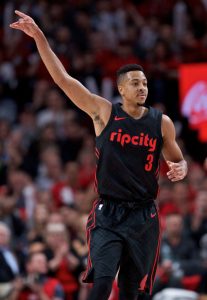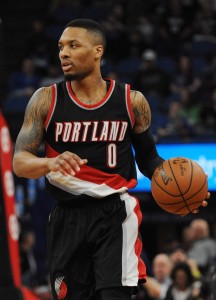The Trail Blazers improved their record by eight games in 2017/18 and claimed the No. 3 seed in a competitive Western Conference. However, their season ended the same way it did the year before, with a first-round playoff sweep. And this time around, that sweep came at the hands of the underdog Pelicans rather than the eventual champions in Golden State.
Portland’s roster will need to undergo some tweaks in order to make the club a contender capable of seriously challenging the Warriors and the other top teams in the West, but a 2016 spending spree has limited the front office’s ability to make adjustments. Finding a way to make upgrades will be the primary challenge this offseason for the cap-strapped Blazers.
Here are five key questions facing the franchise this summer:
 1. Will the Blazers consider breaking up their star backcourt?
1. Will the Blazers consider breaking up their star backcourt?
Damian Lillard and C.J. McCollum were largely responsible for the Blazers’ 49-win season, combining for 48.3 PPG and 10.0 APG between them. Lillard, a three-time All-Star, earned First Team All-NBA honors for the first time in his career this spring, and McCollum is a star in his own right, averaging 21.7 PPG with a .412 3PT% over the last three seasons and virtually never missing a game.
Still, there’s a nagging sense that the Blazers won’t ever win a championship as long as Lillard and McCollum are their two best players. Unlike in Golden State, where the Stephen Curry/Klay Thompson duo thrives due to their varied skill sets, neither of Portland’s star guards is an elite wing defender or excels as a simple catch-and-shoot option on offense.
The Blazers have repeatedly insisted that they won’t break up their star backcourt, but it’s an idea worth considering. Lillard almost certainly won’t go anywhere as long as he’s happy in the Pacific Northwest, but finding the right McCollum deal could kill two birds with one stone — McCollum could net the Blazers an impact player who better balances the roster, and moving his $25.76MM salary might help the team better balance its books.
A shakeup of that magnitude is probably unlikely for a team that had the success Portland did in 2017/18, so I expect both guards to stick with the Blazers to start next season. Still, at some point the front office will have to seriously weigh the idea of a change. If it happens as soon as this summer, it wouldn’t be a total shock.
2. Will the Trail Blazers re-sign Jusuf Nurkic?
Assuming the Blazers move forward with Lillard and McCollum, it’s crucial that the duo is complemented with an impact player in the frontcourt, preferably one who can protect the rim and help make up for defensive lapses on the perimeter. Nurkic initially appeared to be that guy after coming over in a midseason trade with the Nuggets in 2017.
While Nurkic had a solid showing in 2017/18, averaging 14.3 PPG and 9.0 RPG with 1.4 BPG, he struggled with consistency on defense, and his offensive game is still somewhat limited. Nurkic will only turn 24 years old in August, so there’s plenty of time for him to continue to develop, but with restricted free agency looming, the Blazers will have to decide how much of an investment his upside is worth. If Portland bets big on Nurkic, the team could be locked into its current core for years, so a long-term deal is a risk.
On the other hand, Zach Collins may not be ready for a major role and fellow big man Ed Davis is a free agent this offseason too. If the Blazers let Nurkic walk, they’d not only be losing him for nothing — they’d also be potentially creating a major hole in their frontcourt without freeing up any extra cap room to fill that hole.
The Blazers’ decision on Nurkic will be a fascinating one. If another team like the Mavericks swoops in with an aggressive offer sheet in the range of $15-20MM per year, matching that offer would be a tough pill for Portland to swallow, especially since insisting on locking up restricted free agents to big-money deals in 2016 helped create the Blazers’ current cap troubles. Still, Nurkic might have a higher ceiling than any of those previous RFAs, and the club won’t want him to become the one that got away.
3. Are the Blazers ready and willing to become a taxpaying team?
One key factor in the Nurkic equation will be the Blazers’ willingness to pay the luxury tax. The club sidestepped a big tax bill this past season by sending Allen Crabbe and his exorbitant contract to Brooklyn. If Portland re-signs Nurkic for $12-15MM annually, the team will already be right around the 2018/19 tax line with only nine guaranteed salaries on its books.
Another salary dump to escape the tax would be possible, but the Blazers would either have to attach a valuable asset or two to Meyers Leonard or Evan Turner in order to move them, or deal a solid rotation player like Maurice Harkless. In either scenario, Portland might avoid the tax, but the team would be heading into 2018/19 with a roster similar to last season’s and hoping for better results.
President of basketball operations Neil Olshey has talked about wanting to be more aggressive with the tools available to the franchise, including a sizable trade exception acquired in last year’s Crabbe deal. If the Blazers want to re-sign Nurkic and perhaps other key free agents and use their TPE, they may have to be willing to pay the tax.
4. Who are the Blazers’ most likely trade candidates?
As intriguing a trade chip as McCollum would be, the Blazers’ conversations this summer are more likely to focus on a series of players who are a little more expendable. As noted above, Turner and Leonard are probably the two veterans Portland would most like to move, as they’re set to earn $28MM+ combined in 2018/19. They’ll have negative trade value.
Potential trade partners are more likely to target players like Harkless ($10.84MM) and Al-Farouq Aminu ($6.98MM), whose solid play makes them more appealing pieces. However, even if the Blazers get an opportunity to shed those salaries, they may not be eager to sign off. If Portland is unable to retain Davis and/or Pat Connaughton, the team’s depth at the forward position will take a hit, making it more crucial to bring back Harkless at the three and Aminu at the four.
With Lillard and Collins both extremely unlikely to be moved, the only other potential trade candidate on the roster is Caleb Swanigan. However, at just $1.74MM, his cap charge isn’t a problem for the Blazers, who likely want to see more out of last year’s first-round pick before deciding whether or not he’s a keeper.
5. Can the Blazers find an immediate contributor with the No. 24 pick?
If the Blazers have to sacrifice a key rotation player like Harkless or Aminu during the offseason, the club will be under pressure to find low-cost contributors. That could simply mean finding veteran free agents willing to play for the minimum, but Portland’s first-round pick may provide another path to an inexpensive rotation piece.
Although many first-round prospects aren’t ready to play meaningful minutes right away, some players available late in the first round will be more NBA-ready than others. Aaron Holiday, Grayson Allen, Keita Bates-Diop, Khyri Thomas, Melvin Frazier, Jalen Brunson, and Chandler Hutchison are among the potential targets for the Blazers who played at least three college seasons before entering this year’s draft.
Here’s where things currently stand for the Trail Blazers financially:
Guaranteed Salary
- Damian Lillard ($27,977,689)
- C.J. McCollum ($25,759,766)
- Evan Turner ($17,868,853)
- Maurice Harkless ($10,837,079)
- Meyers Leonard ($10,595,506)
- Al-Farouq Aminu ($6,957,105)
- Zach Collins ($3,628,920)
- Andrew Nicholson ($2,844,430) — Waived via stretch provision
- Anderson Varejao ($1,913,345) — Waived via stretch provision
- Caleb Swanigan ($1,740,000)
- Festus Ezeli ($333,333) — Waived via stretch provision
- Total: $110,456,026
Player Options
- None
Team Options
- None
Non-Guaranteed Salary
- Wade Baldwin ($1,544,951)1
- Jake Layman ($1,544,951)2
- Georgios Papagiannis ($1,544,951)3
- Total: $4,634,853
Restricted Free Agents
- Jusuf Nurkic ($4,749,591 qualifying offer / $8,841,915 cap hold): Bird rights
- Shabazz Napier ($3,452,308 qualifying offer / $7,084,080 cap hold): Bird rights
- Pat Connaughton ($1,839,228 qualifying offer / $1,839,228 cap hold): Bird rights
- Total: $17,765,223
Unrestricted Free Agents / Other Cap Holds
- Ed Davis ($12,069,809): Bird rights
- No. 24 overall pick ($1,819,780)
- Total: $13,889,589
Projected Salary Cap: $101,000,000
Projected Cap Room: None
- With over $110MM in guaranteed contracts already on their books for 2018/19, the Blazers have no viable path to cap room, barring multiple trades and/or cuts. In fact, with only eight players accounting for that $110MM+, Portland could easily approach or surpass the tax line once the team’s roster fills out — especially if Nurkic is re-signed.
Footnotes:
- Baldwin’s salary becomes fully guaranteed after July 19.
- Layman’s salary becomes fully guaranteed after June 30.
- Papagiannis’ salary becomes fully guaranteed after July 19.
Note: Rookie scale cap holds are estimates based on salary cap projections and could increase or decrease depending on where the cap lands.
Salary information from Basketball Insiders was used in the creation of this post. Photos courtesy of USA Today Sports Images.
Mmm I think Nurkic has been disappointing… but can they get anything better at the same price?